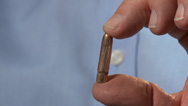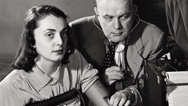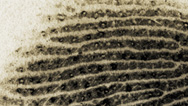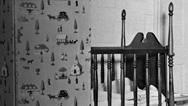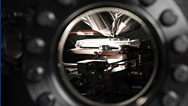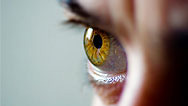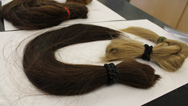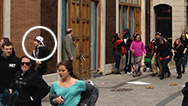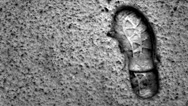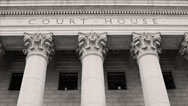
Cold Case JFK
Can modern forensic science uncover fresh clues about the assassination of JFK? Airing August 17, 2016 at 8 pm on PBS Airing August 17, 2016 at 8 pm on PBS
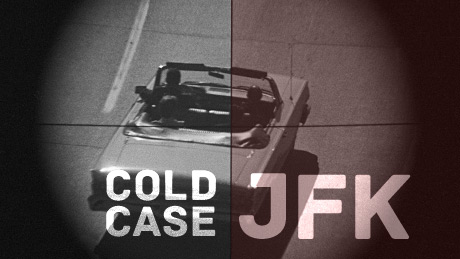
Program Description
Transcript
Cold Case JFK
PBS Airdate: November 13, 2013
NARRATOR: In broad daylight, in front of hundreds of witnesses, a president is murdered.
JOSIAH THOMPSON (Private Investigator): An act of horrific violence.
JIM LEHRER (Journalist): Oh, my god! Is he really dead? Oh, my god! I mean, who did this.
NARRATOR: Within hours, a suspect is arrested: Lee Harvey Oswald. But two days later, he, himself, is killed...
JOSIAH THOMPSON: â¦came out of nowhere.
JOHN MCADAMS (Marquette University): That was really the origin of a lot of conspiracy thinking.
JEFFERSON MORLEY (Journalist): Somebody's trying to silence him.
NARRATOR: Since that time, millions of Americans have been convinced that the assassination was not the work of one man but a conspiracy.
Can modern forensic science and ballistics crack the case. Now, for the first time, using state-of-the-art technology, NOVA brings together a team of experts to analyze the gun, the bullets, the crime scene.G. ROBERT BLAKEY (House Committee on Assassinations): Two shooters in the plaza.
NARRATOR: â¦and the medical evidence.
MICHAEL HAAG (Firearms Expert): The physical evidence doesn't lie.
NARRATOR: Cold Case JFK, right now on NOVA.
In the New Mexico desert, firearms experts tackle an old case that has never really gone cold: the assassination of John F. Kennedy. In 1964, one investigation found there was no conspiracy; 15 years later, a second investigation said there was. Could more sophisticated forensic science provide new insights and uncover the truth about J.F.K.'s murder.
These men believe it can. For two years, they've been working to reconstruct the Kennedy shooting. They're convinced that ballistics is the key to cracking the case.LUKE HAAG (Firearms Expert): Fifty-nine-point-five.
The J.F.K. case is the classic shooting reconstruction case. It's probably the most historic case in the last century.NARRATOR: Luke Haag has been a forensic scientist for 47 years. His specialty is firearms.
LUKE HAAG: Fifty-point-five.
NARRATOR: Working with Luke Haag is another experienced ballistics expert, who also happens to be Luke's son, Michael, Mike, Haag.
MIKE HAAG: Let's go ahead and do one of the vertical angle shots. We've got a nice area of the barrel, right here, that's cylindrical.
My dad is in this business, and I grew up, even in grade school, going out and helping him with casework and research involving firearms.NARRATOR: Mike Haag is an investigator with the Albuquerque Police Crime Lab. He also teaches shooting reconstruction, all over the world.
MIKE HAAG: This part of the class we're looking at multiple different calibers of types of bullets going into cars. The Kennedy assassination is, unfortunately, not as easy, in a way.
NARRATOR: It might seem that reconstructing the Kennedy shooting, which happened in broad daylight, should be simple.
JOSIAH THOMPSON: There were hundreds of spectators there, some 30 people taking photographs, over 50 law enforcement people in Dealey Plaza. You would think it would be the easiest case in the world to solve.
NARRATOR: Among the witnesses is a dress manufacturer with an eight millimeter movie camera: Abraham Zapruder. He shoots 26 seconds that have become the most studied home movie in history.
JOSIAH THOMPSON: He keeps the limo right in frame through the whole thing, as shots are fired, bullets are flying, people are hitting the ground all around him, doesn't faze him.
STEPHEN FAGIN (Historian): Ultimately, the film becomes the crucial piece of visual evidence in the assassination investigation.
NARRATOR: Yet, despite the evidence and witnesses, the J.F.K. case continues to fuel speculation and debate.
ROBERT BLAKEY: The Kennedy assassination is a lot like a Rorschach test: if you look at the evidence, the test, and you give me a statement about the assassination, it really tells me more about you than it does about what happened.
STEPHEN FAGIN: Everything about the assassination which points to Lee Harvey Oswald, I can share with you an alternative explanation which speaks to the possibility of a conspiracy.
LUKE HAAG: The controversies that swirl and develop—I think there's over a thousand books and articles—not a single one of them, to my knowledge, is written by someone who deals with shooting and shooting reconstructions.
NARRATOR: So now, Luke and Mike Haag are focusing on the gun, bullets and crime scene to try and reconstruct one of the most notorious crimes of the 20th century.
It happened in Dallas, on November 22, 1963, a Friday.LUKE HAAG: I remember where I was, I was with my future wife, coming out of a music class.
JOHN MCADAMS: â¦in high school typing class. A fellow who was on staff at the high school came in and said, "They've shot Kennedy...
JEFF MORLEY: I was in kindergarten, and I remember my teacher burst into the room crying.
JOSIAH THOMPSON: A woman ran out of the record store near the corner and said "The president's been shot." I didn't believe it.
ROBERT BLAKEY: I was with Bobby Kennedy the day of the assassination, in a meeting, and we broke for lunch.
JIM LEHRER: I was at Love Field. And I immedâ¦after I got to the City Desk, I called home to talk to my wife, and I said to her, "Let's get out of this place!
CLINT HILL (United States Secret Service Agent, Retired): I was on the left runningboard of the follow-up car, immediately behind the presidential vehicle.
All of a sudden, I heard an explosive noise over my right shoulder. And I saw the president grabbed at his throat, and I knew something was wrong. I jumped off the runningboard of the follow-up car and ran toward the presidential vehicle. As I was running, they tell me there was another shot. I didn't hear it. Just as I was approaching the President's car, there was a third shot. It hit the President in the head, and then it exploded out the right side of his head. Blood and brain matter and bone fragments sprayed out across the people in the car, across the trunk, myself and Mrs. Kennedy. â¦pulled myself up on the rear of the car, and Mrs. Kennedy came out on the trunk. She didn't even know I was there. She wasn't reaching for me. She was reaching for something that came off the president's head. I grabbed her and I put her in the back seat. And I screamed at the driver to get us to a hospital.NARRATOR: At 80 miles an hour, with Clint Hill sprawled across the trunk, they head for Parkland Hospital.
CLINT HILL: The President's head was in Mrs. Kennedy's lap. She wouldn't let go. She didn't want anybody to see the condition he was in, because it was horrible. And so I took off my suit coat. I covered up his head and his upper back and when I did that she let go. And we rushed him into the emergency room.
JOHN MCADAMS: The Dallas doctors try to save him. It was a hopeless case. There was simply no possibility. He'd lost too much brain matter.
NARRATOR: Texas Governor John Connally is also wounded; he will recover.
Back at the crime scene, witnesses point to the Texas School Book Depository.
As police search the building, a TV news cameraman shoots this footage.STEPHEN FAGIN: Deputy Sherriff Luke Mooney, within about 45 minutes of the shooting, discovered three empty rifle cartridges.
NARRATOR: The fired cartridge can be tested and linked to a specific gun. The cartridge case holds the bullet, gunpowder and a primer. When the firing pin strikes the primer, it creates a spark, igniting the powder, which accelerates the bullet through the barrel. After the bullet leaves, the empty cartridge case is ejected from the gun so the next cartridge can be loaded...
The process of loading, firing and ejecting marks the cartridge case with tiny scratches and gouges that can be seen under a microscope. Markings similar to these can prove the three empty cartridge cases were fired by a rifle, also found on the sixth floor.STEPHEN FAGIN: It was only about 10 minutes later that the rifle location was found. A Mannlicher-Carcano wedged between two stacks of boxes.
NARRATOR: The Mannlicher-Carcano, or Carcano, is an Italian rifle made during World War II. The serial number shows this gun was ordered through the mail from Klein's Sporting Goods, in Chicago, by A. Hidell, an alias used by Lee Harvey Oswald.
The Carcano is a military rifle, something that might be popular with gun collectors but is almost never seen by homicide detectives.LUKE HAAG: In the United States, shootings then, shootings now, don't involve military, high-velocity rifles with hard military bullets. Robert Frazier, the F.B.I. examiner, in his testimony, said he'd never seen a 6.5 Carcano. They had no ammunition for this kind of gun in their reference collection. This is the F.B.I...
NARRATOR: Might this highly unusual rifle have characteristics that can shed light on the Kennedy case? Luke and Mike Haag acquire one of these rifles for testing.
LUKE HAAG: This is the 6.5 millimeter. "Car-cano" is the proper pronunciation, though most Americans say "Car-cano.".
It's a mechanically operated bolt-action rifle. It has an offset, inexpensive telescopic sight.NARRATOR: It's clear that for anyone planning an assassination, the Klein's ad offered far better guns: a rifle with a much easier lever action, an American military gun that could shoot eight bullets without stopping, and a small, lightweight carbine that could fire 30 rounds as fast as the shooter could pull the trigger.
By comparison, the bolt-action Carcano is slow and clumsy. So why would any assassin choose the Carcano.LUKE HAAG: It's a matter of price. This was basically a little less than 13 dollars for the rifle, and a little more than seven dollars for the scope. And as far as the awkwardness of it: practice.
NARRATOR: As they test the Carcano, Luke Haag discovers the bullet may be even more unusual than the rifle itself. Unlike civilian bullets, it's made with a full metal jacket, a hard copper shell that surrounds a soft lead core.
LUKE HAAG: Here are four typical military bullets from the first and second World War. They're all full-metal-jacketed bullets...
NARRATOR: They're also pointed. The Carcano is basically a cylinder. The cylindrical shape, with straight sides and no taper or sharp point, affects how the bullet interacts with the rifling, spiral ridges in the wall of the barrel that spin the bullet for stability. Pointed bullets have much less surface area contacting the barrel, so they tend to be less stable as they exit the gun.
LUKE HAAG: They're only gripped by the gun barrel back at the very end of the bullet. This allows the rest of the bullet to do just a little bit of wiggle as it's going up the barrel and as it emerges from the barrel.
The Carcano bullet, the rifling begins grabbing it clear up here at the nose. That's, that's uncommon. I've never seen any other, even other 6.5 rifles that do this.NARRATOR: In 1963, little was known about the Carcano rifle and its unique ammunition, but within hours of Kennedy's death, Dallas police have arrested the man who owns it, Lee Harvey Oswald.
As reporters swarm in, Dallas homicide cops keep working the biggest case of their lives.LUKE HAAG: They had recovered the firearm, cartridge cases, Oswald's fingerprints. They had the case sewed up in an excellent way within two days of the incident. I give them high marks.
DALLAS POLICE OFFICER ONE (News Clip): Physical evidence is the main thing we're relying on.
DALLAS POLICE OFFICER ONE (News Clip): I figure we have sufficient evidence to convict him.
JOHN MCADAMS: The key evidence, essentially all of it, would have been admissible at trial.
NARRATOR: Police are also learning more about Lee Harvey Oswald. An ex-Marine with a security clearance, he's a Communist who lived more than two years in the Soviet Union, raising the terrifying question of Russian involvement.
JIM LEHRER: Was he put up to this by the Russians? As a nation, we would have to take retribution. We would have to fire back, if they killed our president.
NARRATOR: Sunday morning, less than 48 hours since Kennedy's death, Dallas police start transferring Oswald to county jail.
TV REPORTER ONE (News Clip): He's been shot. He's been shot. Harvey Oswald has been shot. There's a man with a gun. It's absolute panic, absolute panic, there is no question about it Oswald has been shot.
NARRATOR: On live television, Oswald is shot and killed by Jack Ruby, a strip club owner with a long arrest record.
JOSIAH THOMPSON: An assassination that came out of nowhere, that had no explanation, now gets weirder and weirder.
NARRATOR: Now there will be no trial, no answers to the questions: did Oswald kill Kennedy? Did he have help? Did Jack Ruby silence him as part of a conspiracy.
JEFFERSON MORLEY: Pollsters go into the field, and, within a week, 60 percent of respondents are saying more than one person was responsible.
JIM LEHRER: There is no question that Ruby killing Oswald raised, big time, the possibility of a conspiracy.
JOHN MCADAMS: Policymakers were very, very sensitive to talk about a Communist conspiracy, because it had very important and very dangerous foreign policy implications.
NARRATOR: Five days later, now-President Lyndon Johnson announces that a commission headed by Chief Justice Earl Warren will investigate.
ROBERT BLAKEY: We're looking back at it now as if all they had to do was just do fact-finding. It's not true. The need that led to the Warren Commission was not to find out what happened, but to assure the American people what didn't happen.
NARRATOR: The Warren Commission will spend 10 months investigating. But before they even start, some of the most critical evidence in the crime of the century has been lost forever.
The problem begins at Parkland Hospital, when John Kennedy is pronounced dead. Dr. Earl Rose, Dallas County Medical Examiner, is required, by law, to perform an autopsy...CLINT HILL: Well, that was not what we wanted to hear. We were going to take the president's body back to Washington.
JOHN MCADAMS: It doesn't exactly come to blows, but there's almost the implicit threat that the Secret Service people will pull their guns if they have to.
CLINT HILL: In the end, they accepted the fact that that's what was going to happen and did happen.
NARRATOR: They take the body to Air Force One.
CLINT HILL: We, the agents who brought the president there to Dallas, alive, vital, energetic, and now we're carrying his body in a casket in the presence of his now-widow, it was very traumatic, quite emotional.
JIM LEHRER: Those Secret Service guys were just beside themselves. You know, trying their best to be cool and calm and professional. To lose a president, good god, there's nothing worse for a Secret Service agent.
NARRATOR: Then, when it seems like nothing else could go wrong for the Secret Service agents, something does.
CLINT HILL: With the handles on, the casket was too wide to go through the doorway.
NARRATOR: As Jacqueline Kennedy waits, they break off the handles.
Returning to Washington, again, the subject of an autopsy is raised.JOSIAH THOMPSON: In a bullet murder, there is no area of evidence more important than the autopsy. You can infer the trajectory of the bullet. So the autopsy in the Kennedy assassination is absolutely critical.
NARRATOR: But the autopsy decision is made by the wrong people for the wrong reasons.
JOHN MCADAMS: The whole Kennedy entourage does not understand the distinction between just an autopsy and a forensic autopsy. Kennedy was a navy man, so the autopsy's going to be done at Bethesda Naval Hospital. A couple of ordinary hospital pathologists are assigned to do the autopsy.
JOSIAH THOMPSON: Meanwhile, nobody asks whether James Humes and J. Thornton Boswell, the two hospital pathologists, are in any way qualified to do this autopsy. They weren't.
VINCENT DI MAIO (Forensic Pathologist): These people were not forensic pathologists. They knew they weren't forensic pathologists, but they were military people, and they were ordered to do the autopsy, so they had to do it.
NARRATOR: Friday evening, Kennedy's autopsy begins. They start with x-rays, which reveal bullet fragments in the brain...
It's also clear that Kennedy had a tracheostomy in the E.R., to insert a breathing tube. But the pathologists don't realize there's a wound there, as well.JOHN MCADAMS: They did not know that the tracheostomy, which they saw, had obscured a wound in the throat.
NARRATOR: Then they find a bullet hole in his back, which quickly becomes a problem.
JOHN MCADAMS: They had what was clearly an entrance wound in the back, and they couldn't account for the bullet.
JOSIAH THOMPSON: The doctors are in a quandary, because they got a bullet hole in Kennedy's back, they did total body x-rays, there's no bullet in the body.
JOHN MCADAMS: So, if a bullet hit Kennedy in the back, where did it go.
NARRATOR: But the doctors aren't shown crucial evidence that would reveal where the bullet went.
VINCENT DI MAIO: The clothing. The clothing had been taken away by the police. Well, examination of the clothing is part of the autopsy, it's very important to know.
NARRATOR: Kennedy's shirt collar and tie show a bullet exited his throat, but doctors don't know that. Then, they learn a bullet has been found on a stretcher at Parkland Hospital. So doctors assume it worked its way out of the body during cardiac massage.
With that, they conclude the autopsy, and the body is taken to lie in state. Now the doctors must write their report, without access to the body, x-rays or photos.VINCENT DI MAIO: This is crazy! I mean these guys saw the wound, why can't they see the photos? And they saw the x-rays only once.
NARRATOR: After speaking with the Dallas E.R. doctors, they conclude Kennedy was hit by two shots fired from behind and above. One went through his neck, the other shattered his skull.
JOHN MCADAMS: So, the bottom line is, Kennedy did not have the kind of autopsy he should have had.
NARRATOR: Because proper measurements and documentation were not done, the Kennedy autopsy will fuel controversy and debate for decades.
But there is another body of evidence still to be dissected, one that allows the murder to be analyzed a fraction of a second at a time: Abraham Zapruder's home movie. Testing Zapruder's camera, the F.B.I. learns a crucial detail.JOSIAH THOMPSON: The Zapruder film chops time up into 18ths of a second. So you have snapshots every 18th of a second.
NARRATOR: Investigators will use the film to establish a timeline. The majority of witnesses heard three shots. The first bullet evidently missed and has never been found.
Most agree the fatal head wound was the third and final shot: Zapruder frame number 313. The earliest sign of trouble is at frame 225, when the car emerges from behind the sign.JOHN MCADAMS: Kennedy has clearly been hit at Zapruder frame 225. Connally's not showing obvious pain until the 235, 6, 7 range.
NARRATOR: Rewinding to before the sign, neither man appears hit. So clearly, both are shot somewhere between frame 210, when they disappear, and frame 240, a timespan of 30 frames.
JOSIAH THOMPSON: So you got 30 Zapruder frames, that's all you've got. And you've got two, two guys to wound...
NARRATOR: Thirty frames is one-point-six seconds.
JOSIAH THOMPSON: But now, whoops, the F.B.I. tested the rifle. It can't be fired that fast. It can onlyâ¦you need two-point-three seconds to fire it twice.
JOHN MCADAMS: There's not enough time for a single gunman to fire two shots during that timeframe.
NARRATOR: So, if a single gunman could not wound both men during that 30-frame interval, there must have been two shooters, a conspiracy.
JEFFERSON MORLEY: Then, if that were true, you had a hell of a problem. It was much more convenient to have one man, one lone nut, was responsible.
NARRATOR: To explain how one shooter could wound both men in one-point-six seconds, Arlen Specter, a lawyer for the Warren Commission, concludes Kennedy and Connally were shot by the same bullet...
JOSIAH THOMPSON: â¦the "single bullet theory," an enormous Achilles' heel in the whole Warren Commission reconstruction.
JOHN MCADAMS: The theory says a bullet hit Kennedy in the back, exited his throat, went on to hit Connally, exited the chest, hit Connally in the wrist breaking the radius bone, and then buried itself very shallowly in his left thigh.
The single bullet theory has traditionally been the single most controversial thing that the Warren Commission came up with...JEFFERSON MORLEY: One of the most important people who didn't believe the single bullet theory was Governor Connally.
NARRATOR: Connally and his wife Nellie disagree with the timing of the theory.
JEFFERSON MORLEY: Connally said, "The first bullet hit Kennedy, and the second bullet hit me." And his wife, Nellie, said the same thing.
NARRATOR: In the film, Connally does appear to react later than Kennedy, as if they were not hit by the same shot.
JEFFERSON MORLEY: For the single bullet theory to be true, Governor Connally had to be wrong. And Connally was completely unequivocal. "That is not what happened." And Connally was an experienced hunter. He was a man who knew his way around a gun.
NARRATOR: Skeptics also point to the condition of the bullet found on Connally's stretcher.
JEFFERSON MORLEY: That bullet was almost pristine. And that's what's called the "magic bullet...
NARRATOR: This is the Carcano bullet the Warren Commission said caused seven separate wounds in Kennedy and Connally...
JOHN MCADAMS: People who see the supposed single bullet will look at it and say it couldn't possibly have inflicted seven wounds, because it ought to be more damaged than that.
LUKE HAAG: How on earth can a rifle bullet go through two people? And, more than that, how can it go through two people and look essentially undamaged.
NARRATOR: Now Luke and Mike Haag are conducting experiments, using the Carcano rifle, to evaluate the single bullet theory.
The first experiment is a test of the stability and penetrating power of the Carcano bullet. Could it pass through Kennedy, Connally's torso, then Connally's wrist and into his thigh? And if so, what condition would it be in. Mike Haag will test-fire one round into one of the oldest ballistic test materials.LUKE HAAG: Pine boards. By setting up a group of boards you can learn a number of things: does the bullet deflect? Is it going to deviate? And once it deviates, is it now going to snap or break or deform? And then, of course, how deep does it go.
NARRATOR: They'll use a timing device called a chronograph and Doppler radar to measure the speed of the bullet, as well as high-speed video.
LUKE HAAG: Velocity 2,089, ten feet beyond the muzzle.
NARRATOR: The instruments show the bullet is traveling just under 2,100 feet per second as it leaves the gun, almost twice the speed of sound, 1,126 feet per second.
High-speed video, recording 20,000 frames per second, shows the Carcano bullet is perfectly straight and stable as it hits the target. The bullet has penetrated 36 inches, but what condition is it in.LUKE HAAG: The nose of this bullet is undeformed: it's still perfectly round. This sort of simple demonstration or experiment shows us a number of things. That this bullet is a very hard, very stable bullet. It's just plowed through three feet of pine boards. These bullets are capable of passing through two human beings.
NARRATOR: But this test only shows the bullet in one medium, wood. In the single bullet theory, it passes through multiple materials: Kennedy's neck, then air, then Connally.
So, the next step is to recreate what happens when a Carcano bullet hits human tissue.LUKE HAAG: It's basically a splash, we're basically a bag of water. If you throw a rock into the water, the water parts. So does muscle tissue, to high-velocity bullets.
NARRATOR: To learn how muscle tissue parts when penetrated by a Carcano bullet, they'll use two different tissue simulants: ballistic gelatin and ballistic soap. Both have the same density and resistance to penetration as human muscle, but they behave differently when struck by a bullet...
LUKE HAAG: We're looking at a temporary cavity in gelatin that opens up and collapses.
NARRATOR: But ballistic soap freezes the moment in time, preserving the wound cavity.
LUKE HAAG: That temporary cavity is formed by the splash, by the plow of the bullet through, but it stays there.
NARRATOR: The pine boards have already shown that a Carcano bullet can easily go straight through two people.
But the single bullet theory is all about what it does after it emerges from Kennedy's neck. Does it remain intact? Is it deflected? What happens to its velocity.LUKE HAAG: How fast was it going? That's important to know. What kind of damage can we expect it to do to another gunshot victim, such as Connally, or to the car.
NARRATOR: In these three feet, the space between Kennedy and Connally, lie the answers that prove or disprove the single bullet theory.
They'll start with the soap.LUKE HAAG: It's very similar to Neutrogena, that clear amber soap that you can see through. This has the same density and same resistivity to penetration as muscle tissue. I've also put this cloth on here, so we can see a phenomenon called "bullet wipe...
First thing to notice is this cloth with the bullet hole in it. The dark ring you see around there is a phenomenon known to forensic scientists as bullet wipe. It's the smudgy material on the surface of a bullet that literally wipes off, as it pushes through the first surface it encounters. This is important because it tells you direction: this is an entry. There is bullet wipe around the small round hole in Kennedy's coat. Okay, I've removed the cloth and the skin simulant. Here we have something different, we have a representative of the temporary cavity, that the tissue would have been hurled out, propelled out. But in a real person, or in tissue or in gelatin, it'd collapse back... This is the exit, and we can see it's very little different in size than the entry. Okay, I've sectioned this length-wise along the wound track, and the noticeable things are that it's perfectly straight.NARRATOR: But near the exit, the wound path gets wider. Something's happening to the bullet.
LUKE HAAG: This is the entrance. The bullet stays stable, stable, stable, nose forward. Over here's the exit, and it's just starting to yaw.
NARRATOR: "Yaw" means the bullet is changing its orientation in flight. It's still moving in a straight line, but it's starting to tumble. High-speed video shows the bullet beginning to yaw after it emerges from the soap.
Now they try a shot through gelatin. The wound path opens up then collapses. And, just like firing through soap, the bullet goes into yaw...LUKE HAAG: Oh, another yawing, tumbling bullet. It's almost in perfect yaw, maybe an eighty instead of a ninety.
NARRATOR: Behind the target is a witness panel, a piece of quarter-inch sheetrock. It's three feet beyond the soap, the same position Connally was in, three feet beyond Kennedy. The witness panel records the bullet's orientation after exiting Kennedy's neck.
LUKE HAAG: We've got an intact bullet. It's not deformed: we can see the profile of it—there's the nose, there's the heel or the base—but it's going sideways.
Here's an actual fired Carcano bullet, and we can see it's almost perfectly in profile. Connally's coat has this kind of a hole in it...NARRATOR: And so does Connally's back, according to his surgeon. In test after test, the Carcano bullet moves straight through tissue simulant, but tumbles when it reenters the air.
LUKE HAAG: Time after time, the instant this bullet is back out into the atmosphere, it goes into yaw. That was a real surprise. I can't explain it, but from a science standpoint, it's repeatable.
NARRATOR: A bullet hitting sideways has much more resistance, which helps explain Connally's wounds...
LUKE HAAG: Just like holding your hand out the window of a car going 90 miles an hour so you feel a lot of resistance: if you put your hand like that you feel very little. So when the bullet hits Connally, it's now going sideways and it does a lot of damage.
NARRATOR: The sideways bullet has a bigger profile and is slowing down. That makes it easy for it to break bones without much damage to itself.
And, in fact, the stretcher bullet is damaged...JOHN MCADAMS: If you look at it end-on, it's mashed very considerably. It's actually in an oval shape, not round. So, it has suffered some damage.
NARRATOR: And it's exactly the type of damage a bullet would get from hitting sideways.
Operating on Connally's wrist, doctors found bits of lead. Luke Haag thinks the soft lead was squeezed out of the bullet's hard copper jacket like toothpaste from a tube, because it was going sideways. A soda can filled with soft plastic illustrates.LUKE HAAG: If I put forces on this this way, and keep it straight, it's strong. If I put force on it like this, now it's going sideways, some of the lead gets squeezed out. 'Cause now the bullet's sideways, when it hits hard bone, some of this breaks off.
NARRATOR: A straight line through J.F.K.'s neck, elliptical holes in Connally's back and coat, with no bullet wipe, bits of lead in the wrist, a bullet noticeably flattened, with lead bulging out the bottom and tests showing the Carcano bullet consistently turns sideways: to Luke Haag, the single bullet theory adds up.
LUKE HAAG: There's no reason not to conclude that the single bullet theory, as proposed by Arlen Specter, is the correct one.
NARRATOR: But there's another Warren conclusion some find hard to accept: that the fatal head shot, the third shot, entered from the rear. It will take 12 years for this controversy to erupt, because the public has never seen the Zapruder film in motion, until March, 1975.
GERALDO RIVERA: This is very heavy. It's the film shot by the Dallas dress manufacter Abraham Zapruder...
NARRATOR: When they're shown the film in motion, viewers are stunned to see the direction Kennedy moves when he's hit in the head.
GERALDO RIVERA: Now, at the bottom of the screen, the head shot. That's the shot that blew off his head. And, as you can see, clearly, the head is thrown violently backwards.
JEFFERSON MORLEY: Kennedy goes backwards like this.
JOHN MCADAMS: Back and to the left.
JOSIAH THOMPSON: He's thrown backwards and to the left.
JEFFERSON MORLEY: If he's hit by a bullet from behind, why would his head go in the direction of that the shot came from? It seems more likely that he was driven backwards by a bullet from the front.
JOSIAH THOMPSON: But the Warren Commission had been telling us all along he got hit in the back of the head.
JOHN MCADAMS: That convinced a lot of people there had to be a conspiracy, because they assumed he was thrown back and to the left by a shot from the right front.
JEFFERSON MORLEY: If there was a shot from the front, then there was clearly two gunmen, and there was some kind of conspiracy.
JOSIAH THOMPSON: And that tidal wave of public concern and anger really eventuated in the formation of the House Select Committee.
NARRATOR: In 1976, the House Select Committee on Assassinations begins investigating the murders of John Kennedy and Martin Luther King.
Three years later, many of their conclusions agree with the Warren Commission: Lee Harvey Oswald fired three shots. The first probably missed, the second hit Kennedy and Connally, the third, the head shot, killed Kennedy. But there is one major difference, and it's a bombshell: the House Select Committee finds there were two gunmen; there was a conspiracy. The evidence for this startling conclusion is audio recordings from a police motorcycle. Some say the recordings indicate a fourth shot. But they've been controversial from the beginning. Experts disagree about what's on the recordings, and the analysis of them has been roundly criticized. In 1982, the National Academy of Sciences examined the acoustic evidence.JOHN MCADAMS: They concluded, no, these conclusions are simply invalid.
JEFFERSON MORLEY: And so, the acoustic evidence, while I find it very interesting, I would say, it's not decisive...
NARRATOR: But controversial recordings aside, what did witnesses actually hear.
JOHN MCADAMS: A fair number of witnesses said the shots came from the Depository, and a fair number from the direction of the grassy knoll.
NARRATOR: The grassy knoll is a slight rise on the northwest side of Dealey Plaza. If there were a gunman here, that could explain a shot from the right front.
But many witnesses simply weren't sure where shots came from.JOHN MCADAMS: A fair number of people, when asked where the shots came from, said there was no way to tell, there was too much reverberation.
NARRATOR: The Kennedy assassination is just one example of the difficulty of pinpointing gunshots. Locating where shots are coming from is hard for anyone, even trained soldiers, especially in urban environments.
MICHAEL HARGATHER (New Mexico Institute of Mining and Technology): It's a major problem for our soldiers in Iraq and Afghanistan, to be able to understand where shooters are in these urban environments. Multiple buildings, multiple locations that the shockwaves reverberate off of, can give us multiple sound signatures.
NARRATOR: At New Mexico Tech, Professor Michael Hargather studies shock waves caused by explosions. Using a special high-speed camera, extremely bright focused light and a reflective screen, his team takes pictures of sound...
MICHAEL HARGATHER: We can literally photograph the invisible, small density differences within the air.
What we're going to see here, with the shadowgraph system is, we're going to see a line that is the shadow cast by that shockwave. That line represents the interface between the unshocked ambient air, and, then, what we call the "shocked air" behind that shockwave. John, you ready.JOHN: Ready.
NARRATOR: Photographing a high-speed rifle bullet reveals two different shockwaves: one,V-shaped, is created by the bullet traveling faster than the speed of sound, the other by the gases that propel it.
MICHAEL HARGATHER: There's really multiple pieces to this event: the bullet, we can talk about it being supersonic as it exits the gun, because it's travelling faster than the speed of sound; and the burning of the gunpowder that produces what we call a muzzle blast.
NARRATOR: So, with a supersonic rifle bullet, like the Carcano, an observer can hear two sounds: the crack of the bullet passing, followed by the blast of the gun that fired it, like so, all bouncing and echoing between the buildings in Dealey Plaza.
MICHAEL HARGATHER: In a complicated geometry, like Dealey Plaza in Dallas, you could get multiple shock reflections in that geometry. And so someone could hear multiple sounds from a single shot.
NARRATOR: But regardless of what people heard, was a shot from the grassy knoll even possible? To hit Kennedy from the right front, possibly explaining why he moved back and to the left, what trajectory would the bullet have had to take.
In 1963, the Warren Commission had to calculate trajectories manually. Today, investigators have a different tool: 3D laser scanning.TONY GRISSIM (Technical Advisor, 3D Laser Scanning): What the laser scanner does is it spins around and it makes millions and millions of laser measurements that are very, very accurate. The result is, it greatly enhances the data collection process at a crime scene.
NARRATOR: Laser scan specialist Tony Grissim is working with ballistics expert Mike Haag to create a 3D virtual model of Dealey Plaza.
TONY GRISSIM: The laser system is going to put a laser up into the mirror system, which directs it at a 90 degree angle over to this enclosed cube. And then, when the laser rotates around the scene, you're able to come away with 360 degrees of data.
NARRATOR: The first step is to scan from multiple points in the plaza, including the sixth floor of the book depository.
MIKE HAAG: When I first started in this business, if you went into a typical crime scene, you might walk out having used your tape measure, your roller wheel, and it was inevitable that you would realize later that you missed a measurement.
LUKE HAAG: Do we know the camber of the road? Do we know how high the curb was? Did you take it? I didn't take it. Did you? It's all in the computer...
TONY GRISSIM: We've done a panoramic scan already. Now we're going to do what's called a detailed scan just of the actual window...
NARRATOR: Processing such a huge amount of data will take weeks.
When it's done, all of Dealey Plaza, every building, window, streetlamp and tree, exists in a computer, accurate to an eighth of an inch.MIKE HAAG: Mike, can we go and take a vantage point, looking at the grassy knoll and pick some points and look at distances and trajectory from there to the limousine location when the headshot actually occurred.
The 3D laser scan data allows me to look at any shot I want to, including the grassy knoll shot, the shots from the 6th floor, missed shots, anything.NARRATOR: It's all about angles and distances.
MIKE HAAG: I'm interested in the distance from the knoll to, say, the headshot, and the knoll to the neck shot.
NARRATOR: Mike Haag wants to evaluate a grassy knoll trajectory.
MIKE MCCORMICK: Here's the corner of the stockade fence...
MIKE HAAG: Maybe right about behind that tree, around in there. Could we also see what the vertical angle would be, the downward angle? So, from the top of the stockade fence, for example, to the president's head?
MIKE MCCORMICK: Sure.
MIKE HAAG: If it came from the knoll, we're looking at about 105 feet...
MIKE MCCORMICK: That's correct.
NARRATOR: When the distances and angles are all calculated, the answer is clear.
MIKE HAAG: So 105 feet, minus four degrees downward, if we define horizontal as zero.
NARRATOR: In the 3D virtual Dealey Plaza, a trajectory from the grassy knoll to Kennedy is possible.
MIKE HAAG: The distances are certainly within realm of a typical firearm, but you would have to have had an entrance wound in the front right area of the president's head.
NARRATOR: Clearly, the right side of Kennedy's head is terribly injured. His skull is shattered into multiple pieces. But is this devastating damage an entrance wound? The only way to know for sure would be to examine Kennedy's skull.
Since that's impossible, a team at the Boston University School of Medicine will instead try to virtually reconstruct Kennedy's head wound. Greg Mahoney is a forensic artist; James Pokines, a forensic anthropologist. Leading the team is Peter Cummings, a pathologist who specializes in gunshot wounds to the head.PETER CUMMINGS (Forensic Pathologist): What I typically do with a gunshot wound to the head case is I'll try to reconstruct the skull by taking the fragments and putting them back into the place where they belong, anatomically.
NARRATOR: Several fragments of Kennedy's skull were recovered from his scalp, the limousine and Dealey Plaza.
To see if there's any sign of a shot from the grassy knoll, the team tries to piece together the fragments. Cummings hopes that reconstructing the skull will show if there's an entry wound in the right front. When the process is complete, the team sees only evidence of a rear entry wound.JAMES POKINES (Forensic Anthropologist): Everything I've seen is consistent with a relatively simple scenario: bullet enters here and comes out roughly in this area.
PETE CUMMINGS: I don't know where the exit wound is. There's not a discrete exit point.
NARRATOR: But this is only an experiment, using publicly available copies of autopsy photos and x-rays. To learn more, Cummings goes to the National Archives, where the high quality originals and Kennedy's clothing are kept.
The Kennedy family has granted him access, on NOVA's behalf, but no cameras are allowed.PETE CUMMINGS: It was a real honor. It's something that I grew up with. As a boy, seeing the Zapruder film was one of the things that really fueled my interest in doing forensics. This was John F. Kennedy, and I was handling his clothing. Even though I went there for a very specific reason, and a scientific reason, certainly that moment wasn't lost on me.
The photographs themselves are crystal clear. The sharpness is amazing. You can get a lot of detail from them. Much better than anything you can find that's publicly available.NARRATOR: Even so, they're not perfect. A photo intended to document the entry point is unclear, because, for whatever reason, the autopsy doctors did not shave the head wound.
The brain yields more information.PETE CUMMINGS: This is a drawing of President Kennedy's brain, that was done for one of the investigative committees. We see the wound track that extends from the occipital pole, the back of the brain, the back tip of the brain, all the way up through the front of the brain.
NARRATOR: A shot from the grassy knoll would have exited through the left side of Kennedy's brain, but that is largely undamaged. Moving on to an x-ray of Kennedy's skull, multiple fractures are evident. The pattern of fracture lines is a clue to the bullet's direction.
PETE CUMMINGS: As the bullet impacts the skull, the fracture lines will radiate off from that point of impact. As that's happening, the head is also expanding from this incredible pressure wave that's occurring inside the head...
NARRATOR: In tests at the Biophysics Laboratory, an Army research center, Carcano bullets were fired into human skulls filled with ballistic gelatin. First, the impact of a bullet entering from the rear causes fractures to radiate forward. But almost at the same instant, a pressure wave inside the gelatin causes a second wave of fractures in a perpendicular direction, just like what Cummings sees on the Kennedy x-ray.
PETE CUMMINGS: So, you have these long fractures that'll radiate out from an entry wound, and then you have these concentric fractures that happen perpendicular to the original fracture lines.
NARRATOR: If Kennedy had been shot from the grassy knoll, the primary fracture lines would radiate backwards from the front, but the x-ray shows the opposite: they radiate forward from the rear.
PETE CUMMINGS: Based on this fracture pattern in this skull, I think we can definitively say, "No. There was no shot from the side or from the front...
NARRATOR: But there is one lingering mystery: where exactly was the entry wound? For 50 years, confusion over its precise location has fueled controversy. The autopsy doctors said it was low; the House Committee put it four inches higher. One scientist thinks the autopsy doctors were right. Larry Sturdivan is an expert in wound ballistics. He worked at the Army Biophysics Lab where the skull tests were done.
Sturdivan thinks the House Committee assumed there must be a straight line from the bullet's entry to exit, in order to line up with the sixth floor window.LARRY STURDIVAN (Wound Ballistics Researcher): Probably the reason that they developed the higher impact was simply to explain the fact that sort of line could line up with the school book depository window. I don't know why they assumed that it had to make a straight path.
NARRATOR: In the test at the Biophysics Lab, Carcano bullets did not follow a straight path inside the skull, because they were deformed and destabilized on impact.
LARRY STURDIVAN: The bone is hard enough and strong enough and dense enough to deform the bullet. When it destabilizes, it begins to yaw. As soon as it begins to yaw, it develops a lift force, like an airplane wing, and it will inevitably take a curved path.
NARRATOR: This is consistent with the physical evidence. The bullet that hit Kennedy's head fragmented, leaving pieces in the brain and in the car. Sturdivan thinks the pressure wave created by the bullet inside the brain also explains Kennedy's movement backward.
LARRY STURDIVAN: The tissue inside the skull was being moved around. It caused a massive amount of nerve stimulation to go down his spine. Every nerve in his body was stimulated. Now, since the back muscles are stronger than the abdominal muscles, that meant that Kennedy arched dramatically backwards.
NARRATOR: After 50 years, one of the most witnessed murders in history is still discussed and debated. Science can explain some things: how a relatively intact Carcano bullet could wound two men and how a shot from behind could cause Kennedy's backward movement. But when it comes to the Kennedy assassination, there are explanations science cannot provide.
JOHN MCADAMS: History doesn't always make sense. Here's a nothing person, you know, who brought down the leader of the free world.
JIM LEHRER: In a few seconds, one guy gets off three rounds, chook, chook, chook, changes the course of history forever.
NARRATOR: No experiments can show why someone would take a rifle to a high window and pull the trigger. But they can show it's probable that Lee Harvey Oswald did and that his shots alone killed President John F. Kennedy.
LUKE HAAG: The essence of good forensic science is to look at what are the competing explanations of an event. And if you can rule out that which is impossible, that which remains, however seemingly improbable, is the truth.
Broadcast Credits
- PRODUCED BY
- Rushmore DeNooyer and Scott Tiffany
- WRITTEN AND DIRECTED BY
- Rushmore DeNooyer
- EDITED BY
- Ryan Shepheard
Steve Audette
Jean Dunoyer - ASSOCIATE PRODUCERS
- Adam Costa
Britt Knowlton
Parks Stephenson - CAMERA
- Jesse Colaizzi
Phil Cormier
Adam Costa
Doug Crawford
Mark Denney
Joe Friedman
Jerry Hattan
Robert Humphreys
Jim Iacona
Tom Kaufman
Kobi Zaig - HIGH SPEED CAMERA
- Rana Weaver
Jesse Tobin - SOUND RECORDISTS
- Gillian Arthur
Brian Copenhagen
Kevin Crawford
Tracy Duncan
Randy Foster
Zach Mueller
Stephen Nelson
Pete Nenortas
Denielle Rose
Tom Staton
Jim Gallup - NARRATED BY
- Jay O. Sanders
- ASSISTANT CAMERA
- Tim Johnston
- MUSIC
- ScoreKeepers Music
- ANIMATION
- Doug Quade
Ryan Shepheard
Jared Flynn - PRODUCTION MANAGER
- Chris Bailey
- ASSISTANT EDITORS
- Tiffany Dixon
Eric Gulliver
Kyle Kenyon - ONLINE EDITOR AND COLORIST
- Jim Ferguson
- AUDIO MIX
- Heart Punch Studio Inc.
- ARCHIVAL RESEARCH
- Kate Coe
Rich Remsberg - TECHNICAL ADVISOR, 3D LASER SCANNING
- Tony Grissim
- PRODUCTION ASSISTANTS
- Mark Burchick
Aria Rastandeh
Parks Stephenson - ARCHIVAL MATERIAL
- AP Archives
AP Images
Conus Archive
Corbis Images
Corbis Motion
Critical Past
Film Archives
Getty
Luke Haag
ITN
JFK Library
LBJ Library
National Archives
Shutterstock
Footage © The Sixth Floor Museum at Dealey Plaza:
Abraham Zapruder Film, 1967
KRLD-TV / KDFW-TV Collection, 1995
KTVT-TV Collection, 1995
WFAA-TV Collection, 1998
Roy Cooper, KTVT-TV Collection, 1996
Larry Sturdivan
T3 Media
WPA - SPECIAL THANKS
- 3D Systems
Alyce Decker
Gina DiGravio
Steve Irwin
Leica Geosystems
Mike McCormick
Don Siwek - HISTORICAL CONSULTANTS
- John McAdams
Gerald Posner - EXECUTIVE PRODUCER FOR LONE WOLF
- Kirk Wolfinger
- NOVA SERIES GRAPHICS
- yU + co.
- NOVA THEME MUSIC
- Walter Werzowa
John Luker
Musikvergnuegen, Inc. - ADDITIONAL NOVA THEME MUSIC
- Ray Loring
Rob Morsberger - CLOSED CAPTIONING
- The Caption Center
- POST PRODUCTION ONLINE EDITOR
- Jim Ferguson
- PUBLICITY
- Eileen Campion
Eddie Ward - SENIOR RESEARCHER
- Kate Becker
- NOVA ADMINISTRATOR
- Kristen Sommerhalter
- PRODUCTION COORDINATOR
- Linda Callahan
- PARALEGAL
- Sarah Erlandson
- TALENT RELATIONS
- Scott Kardel, Esq. Janice Flood
- LEGAL COUNSEL
- Susan Rosen
- DIRECTOR OF EDUCATION
- Rachel Connolly
- DIGITAL MANAGING PRODUCER
- Kristine Allington
- SENIOR DIGITAL EDITOR
- Tim De Chant
- DIRECTOR OF NEW MEDIA
- Lauren Aguirre
- DEVELOPMENT ASSOCIATE
- Lisa Leombruni
- UNIT MANAGER
- Ariam McCrary
- PRODUCTION MANAGER
- Stephanie Mills
- POST PRODUCTION ASSISTANT
- Brittany Flynn
- POST PRODUCTION EDITOR
- Rebecca Nieto
- POST PRODUCTION MANAGER
- Nathan Gunner
- COMPLIANCE MANAGER
- Linzy Emery
- BUSINESS MANAGER
- Elizabeth Benjes
- DEVELOPMENT PRODUCER
- David Condon
- PROJECT DIRECTOR
- Pamela Rosenstein
- COORDINATING PRODUCER
- Laurie Cahalane
- SENIOR SCIENCE EDITOR
- Evan Hadingham
- SENIOR PRODUCERS
- Julia Cort
Chris Schmidt - SENIOR SERIES PRODUCER
- Melanie Wallace
- MANAGING DIRECTOR
- Alan Ritsko
- SENIOR EXECUTIVE PRODUCER
- Paula S. Apsell
A NOVA Production by Lone Wolf Media for WGBH/Boston
© 2013 WGBH Educational Foundation
All rights reserved
This program was produced by WGBH, which is solely responsible for its content.
IMAGE:
- Warren Commission Reenactment Kennedy assassination
- © CORBIS
Participants
- G. Robert Blakey
- House Committee On Assassinations
- Peter Cummings
- Forensic Pathologist
- Vincent di Maio
- Forensic Pathologist
- Stephen Fagin
- Historian
- Tony Grissim
- Tech. Advisor, 3D Laser Scanning
- Luke Haag
- Mike Haag
- Firearms Expert
- Michael Hargather
- New Mexico Tech
- Clint Hill
- Secret Service Agent (Ret'd)
- Jim Lehrer
- Journalist
- Greg Mahoney
- Forensic Artist
- John McAdams
- Marquette University
- Jefferson Morley
- Journalist
- James Pokines
- Forensic Anthropologist
- Larry Sturdivan
- Wound Ballistics Researcher
- Josiah Thompson
- Private Investigator
Preview | 00:30
Full Program
Full program available for streaming through
Watch Online
Full program available
Soon

